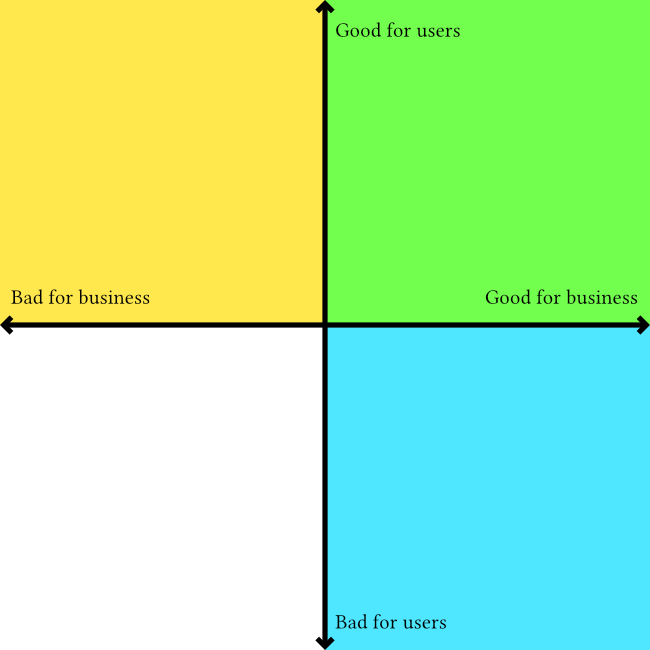Feedback types: Is this a thing? / challenging perspectives / general opinions
Here’s an outline which I originally posted as a tweet thread but would like to flesh out into a fill article with images like the attached one to illustrate the “zones” that people may/may not realise they are acting in when they say stuff like “what’s good for the user is good for the business”
I am writing this because I’ve published a few things now which say that empathy and “human centeredness” in commercial design, particularly UX design/research, are theatrical and not compatible with capitalism if done deliberately. That means they can be true as a side-effect, or by individuals acting under the radar of their employers. It has become common to hear the good for the user = good for the business response - and I want to write something that demonstrates how it is an incomplete sentence, and any way to add the necessary information to make it true results in the speaker admitting they are not acting in the interests of users or humans.
Here’s the basic outline so far:
What’s good for the User
“What’s good for the user is good for the business” is a common response I get to my UX critique. When I try to understand the thinking behind that response I come up with two possible conclusions:
Conclusion 1: They are ignoring the underlying product and speaking exclusively about the things between the product and a person. They are saying that making anything easy to use, intuitive, pleasant, makes a happy user and a happy user is good for business.
This type of “good for the user” is a business interest that values engagement over ethics. It justifies one-click purchases of crypto shitcoins, free drinks at a casino, and self-lighting cigarettes. https://patents.google.com/patent/US1327139
Conclusion 2: They are speaking exclusively about the underlying product and the purposes it was created to serve. They say a good product will benefit the business. But this means they are making a judgement call on what makes a product “good”.
This type of “good for the user” is complicated because it is a combination of objective and subjective consideration of each product individually. It is design in its least reductive form because the creation of something good is the same with or without business interests. A designer shouldn’t use blanket statements agnostic to the design subject. “what is good for the user…” ignores cigarette packet health warnings and poker machine helpline stickers there because of enforced regulation, not because of a business paying designers to create them.
It’s about being aware of the context, intent, and whose interests are being served. It means cutting implied empathy for people if it is bullshit.
If we look at this cartesian plane diagram we can see the blue and green quadrants that corporate product design operates in. The green being where the “good for user, good for business” idea exists, and the yellow representing the area that the idea ignores, dismisses, etc



GDPR is a great example of this. I would say it’s biggest failing was in recognising all of the nuances and scenario variability while forgetting that most businesses would take the easiest route regardless of how it impacted people. Especially that they would establish the gdpr-consent-popup as a norm which works like a bendy mirror on the gdpr “Look what your policy has made us do to the internet!”
Google Tag Manager (GTM) is the tool that opened up the ability for marketing and sales people to push scripts to a website without any understanding of the broader impact.
What you’re saying about adtech is incredibly true, and GDPR isn’t just scary because they think what they are doing is unethical, it’s because GDPR would require them to understand everything they are doing. Something which tools like GTM make almost impossible because it lets them plug in a bunch of scripts which write in scripts that write in scripts. I worked as a FE dev for an ad-revenue based publishing company in Australia during the GTM boom and the forensics work I had to do to find which tracking/content syndication script was breaking everything was mind-numbing. These things bypass the developers by design, because developers don’t necessarily care about people either but they do care about their reputation in code.
The email unsubscribe link might be another good example of what you’re saying where it starts off as a good thing but quickly becomes a bandwagon that benefits from perceived goodwill but is another data collection opportunity.
haha here’s a mod of my diagram to show what I cringe-call “empathy drift” where anything that starts out as being done without regard for, or even adversarial to, business for the benefit of people and becomes somewhat popular will be adopted by business because of the perceived goodwill and continue the rotational journey into oblivion.
deleted by creator
This is kind of like something I’ve badly written about before called “effective automation” where instead of using computing power to make everything easier by default we can find opportunities to use that power to make things more involved, or to require more involvement from us because they are things that benefit from our deliberate attention, deliberate attention that is mistaken as friction https://fasterandworse.com/ineffective-automation/